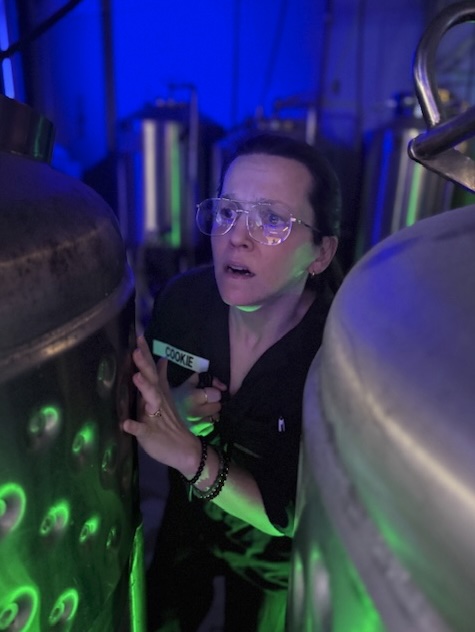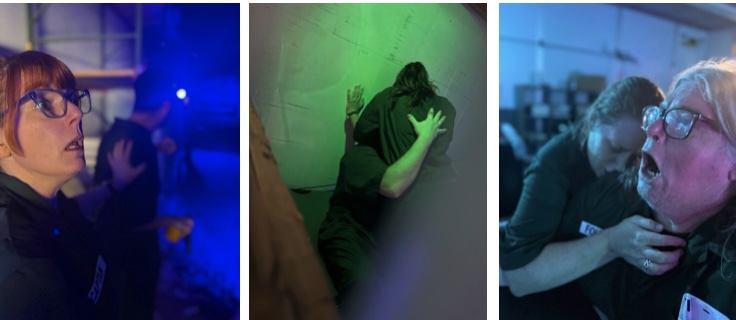Review: SPEAK NO MORE: CONTAGION by La Fenice
by Brian Paul Scipione
La Fenice (Italian for The Phoenix) was originally founded in 1999 as the Austin Commedia Society. They are a modern commedia dell'arte troupe based on Italian theatrical convention that originated more than five hundred years ago. Commedia dell'arte (roughly, comedy of professional artists) is known for combing scripted and improvised elements, physical comedy, stock scenarios, and archetypical or even stereotypical characters. It was often done with satirical intent, most often taking aim at class hierarchy. It began during the Renaissance and eventually spread throughout Europe.
 La Fenice’s current production in collaboration with Golden: Silent Improvised Stories is Speak No More: Contagion,the latest in their series of silent performances with environmental themes. This one's science fiction setting iwas nspired by three of the greatest sci-fi horror movies ever put to celluloid: Alien, The Abyss, and The Thing. To achieve the vibe of a space research station, La Fenice staged it in the dimly lit manufacturing section of Independence Brewery. Adding to this vibe was a total lack of air conditioning, unfortunately, which made the show’s sweaty feel a bit too realistic. It also caused the majority of the wandering audience to keep waving their hand fans, which peripherally drew attention away from the action (pun intended).
La Fenice’s current production in collaboration with Golden: Silent Improvised Stories is Speak No More: Contagion,the latest in their series of silent performances with environmental themes. This one's science fiction setting iwas nspired by three of the greatest sci-fi horror movies ever put to celluloid: Alien, The Abyss, and The Thing. To achieve the vibe of a space research station, La Fenice staged it in the dimly lit manufacturing section of Independence Brewery. Adding to this vibe was a total lack of air conditioning, unfortunately, which made the show’s sweaty feel a bit too realistic. It also caused the majority of the wandering audience to keep waving their hand fans, which peripherally drew attention away from the action (pun intended).
The premise for the play: “The crew of the Remote Research Outpost 3196 that survived the breech of protocol that terrible night never spoke of it again.” Arriving audience members are handed simplified Venetian-style masks to wear throughout the performance. Some receive random cards to give the cast right before the show. These cards reveal to the performers what their role will be that evening. This ups the improvisational stakes. There were eleven different roles, which is quite a bit more than the four to six archetypes in traditional commedia dell’arte. These included such things as traitor, patient zero, and android. The audience is told that the performance will be played through three times. This gives everyone the chance to observe different parts of the story that happened in three separate settings of the research facility: the cafeteria, the production area, and the lab/sick bay. This is a super fun concept. It' inherently exciting to choose either to stay still like a fly on the wall or to chase the actors around in an attempt to follow the plot.
The only voice you hear is that from computer, explaining that what you are about to see is a simulation that will replayed three times. It posits the question: Is what you're about to see a matter of human failure or computer failure? Just before the simulation begins, the incorporal voice states, “We shall speak no more,” which not only echoes the title but sets an ominous tone. And it's ominous indeed as you creep around, an invisible voyeur knowing that not only is something terrible going to happen but it may happen right under your nose.
Your brain kicks into detective mode as you seek to crack the mystery of who’s to blame. One of the first scenes you witness is mealtime in the cafeteria. This seems like a good opportunity to get the lay of the land and observe how characters interact. Is this a red herring? Upon a rewatch you realize there's a major containment emergency happening in the other room at the same time. The intensity is high and anticipation is all. And then it happens all over again, and you must decide: Do I ignore the meal? Or did I miss something important in that scene?

The sound design of this play is spectacular. Just as a good soundtrack is essential to a horror movie (people very often remember the soundtrack more clearly than the plot), the ebb and flow of the musical choices not only queues the actors and keeps the performance in sync; it rivets up the tensions and increases the claustrophobic atmosphere. The story begins with the high camaraderie of mealtime and quickly devolves into a maelstrom of violence, contagious sickness, and universal panic. The spectator'smind whirls. Who’s infecting whom? Is involuntary manslaughter carried out in the guise of self defense justified? Did the computer truly fail to protect the humans or did human desperation defy technology?
The truth: I had no idea. The eleven cards were handed out so quickly beforehand that I recalled the assigned roles of only three or four. And the witty name tags on the uniforms weren't related to the roles. So, in the end it wouldn’t have mattered how many times I watched the simulation; I would still have been lost. I compared notes with other audience members and found we seemed to have seendifferent plays, which of course was the point, at least in a way.
This was definitely an enjoyable night of theater, like watching a rock and roll concert in a foreign language: visceral, experiential, and utterly incoherent.
Speak No More: Contagion
by Speak No more ensemble
La Fenice
October 10 - November 02, 2025
somewhere in Austin
to be announced
Austin, TX, 78700
- Dates: October 10 - November 2, 2025
- Schedule: Friday, Saturday, and Sunday performances at 8 pm
- Location: Independence Brewery (abandoned laboratory space)
- Format: Silent, site-specific, immersive theater
- Recommended for: Ages 20-50
La Fenice and Golden: Silent Improvised Plays announce the next installment of their acclaimed "Speak No More" series with "Speak No More: Contagion," a site-specific, immersive theatrical experience that plunges audiences into the heart of a chilling sci-fi nightmare.
Performances are held in an abandoned laboratory in the depths of Independence Brewery. The unconventional venue adds an authentic layer of industrial decay and scientific mystery that perfectly complements the production's themes of contamination and isolation.